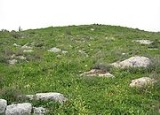
Khirbet Sharta
Encyclopedia
Khirbet Sharta is an ancient tell
in northern Israel
, northeast of Kiryat Atta, that covers two hills.
 In 1965, the Israel Antiquities Authority
In 1965, the Israel Antiquities Authority
conducted excavations of the western hill prior to the construction of residential housing in Kiryat Atta.
Discoveries include burial caves with remains from the Bronze
, Iron
, Hellenistic
, Roman
, Byzantine
, and Arabic
eras.The eastern hill is still unexcavated, with visible remains of a 150-meter stone wall built with a double row of large stones, rock cuttings and two wine presses.
impression, previously thought to have been limited to southern Israel. Similar specimens have been recovered from three other northern sites, the most important being Nahal Tut
.
Tell
A tell or tel, is a type of archaeological mound created by human occupation and abandonment of a geographical site over many centuries. A classic tell looks like a low, truncated cone with a flat top and sloping sides.-Archaeology:A tell is a hill created by different civilizations living and...
in northern Israel
Israel
The State of Israel is a parliamentary republic located in the Middle East, along the eastern shore of the Mediterranean Sea...
, northeast of Kiryat Atta, that covers two hills.
Archaeology

Israel Antiquities Authority
The Israel Antiquities Authority is an independent Israeli governmental authority responsible for enforcing the 1978 Law of Antiquities. The IAA regulates excavation and conservation, and promotes research...
conducted excavations of the western hill prior to the construction of residential housing in Kiryat Atta.
Discoveries include burial caves with remains from the Bronze
Bronze Age
The Bronze Age is a period characterized by the use of copper and its alloy bronze as the chief hard materials in the manufacture of some implements and weapons. Chronologically, it stands between the Stone Age and Iron Age...
, Iron
Iron Age
The Iron Age is the archaeological period generally occurring after the Bronze Age, marked by the prevalent use of iron. The early period of the age is characterized by the widespread use of iron or steel. The adoption of such material coincided with other changes in society, including differing...
, Hellenistic
Hellenistic period
The Hellenistic period or Hellenistic era describes the time which followed the conquests of Alexander the Great. It was so named by the historian J. G. Droysen. During this time, Greek cultural influence and power was at its zenith in Europe and Asia...
, Roman
Roman Empire
The Roman Empire was the post-Republican period of the ancient Roman civilization, characterised by an autocratic form of government and large territorial holdings in Europe and around the Mediterranean....
, Byzantine
Byzantine Empire
The Byzantine Empire was the Eastern Roman Empire during the periods of Late Antiquity and the Middle Ages, centred on the capital of Constantinople. Known simply as the Roman Empire or Romania to its inhabitants and neighbours, the Empire was the direct continuation of the Ancient Roman State...
, and Arabic
Mamluk
A Mamluk was a soldier of slave origin, who were predominantly Cumans/Kipchaks The "mamluk phenomenon", as David Ayalon dubbed the creation of the specific warrior...
eras.The eastern hill is still unexcavated, with visible remains of a 150-meter stone wall built with a double row of large stones, rock cuttings and two wine presses.
Significance
Khirbet Sharta was the first site in the region scientifically excavated that produced a jar handle with a LMLK sealLMLK seal
LMLK seals were stamped on the handles of large storage jars mostly in and around Jerusalem during the reign of King Hezekiah based on several complete jars found in situ buried under a destruction layer caused by Sennacherib at Lachish...
impression, previously thought to have been limited to southern Israel. Similar specimens have been recovered from three other northern sites, the most important being Nahal Tut
Nahal Tut
Nahal Tut is an archaeological site excavated along the streambed of the same name in northern Israel's Menashe Heights from February to July of 2005 by Amir Gorzalczany and Gerald Finkielsztejn in preparation for the northward extension of Highway 6...
.

